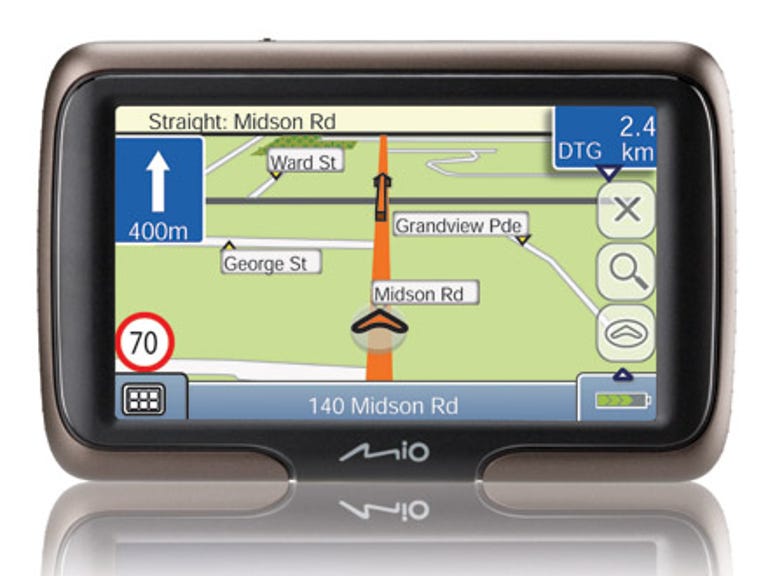 Why You Can Trust CNET
Why You Can Trust CNET Mio A430 review: Mio A430
It may be a frill-free zone, but the Mio A430 offers plenty of screen girth for the money. Pity then that the camera and school zone warnings are nigh on useless.
We can almost see the ad copy right now: "A 4.3-inch GPS for the price of a 3.5-inch unit!" So what compromises have been foisted upon the A430 to achieve this?
The Good
The Bad
The Bottom Line
Design
The beige-grey screen bezel and dimpled edging had us thinking that the A430 was a rugged go anywhere device. Thankfully common sense took hold and we resisted our primeval urges to drown it in a bucket of water. False pretences aside and given its station in life, it's quite an attractive little number.
Along the top there's a multifunction on/off/reset slide switch and that's pretty much it for the physical controls. Everything else is controlled via the 4.3-inch touchscreen. The interface, with its blue hues and friendly layout, is practically a straight lift from last year's range and earlier Navman models, with visual upgrades limited to smoothed out fonts. The map screen is not overly cluttered with buttons and info, and the map itself is neat, legible and bright, with directions easy to discern.
Destination entry is slowed down somewhat by the predictive text feature that's constantly working in the background, sorting through all the possible streets. At first blush, the enabled-by-default "speak keyboard letters" is annoying to a fault, but with a bit of use we discovered that it was entirely necessary otherwise we just wouldn't know whether the letter we'd just pawed has been registered.
Also keep in mind that certain popular street names, such as George, return more entries than can be displayed in the Mio's results window, so you'll need to restrict searches to a suburb or, in the case of capital city CBDs, a postcode.
The windscreen mount is practically the same unit that's been used in Navmans and Mios for the last few years. It's suitably compact, allowing the whole device to fit neatly in all but the tiniest of gloveboxes, and won't leave its place on the glass without a good fight.
Features
Pricier 4.3-inch models from rival brands usually feature niceties like traffic messaging, junction view, music playback and FM transmission — these were naturally given the old heave-ho by the razor gang. Text-to-speech, for spoken street names, and camera and school zone warnings did make the cut though.
While undoubtedly nice to have, this Mio's text-to-speech system is marred by odd inflections, mispronunciations — Bork Road anyone? — and the rather superfluous use of road numbers in addition to street names, for example, "Highway 66 Sydney Park Road".
Locations for speed and red light cameras, as well as school zones, are heralded by a loud, albeit generic, warning chime. The on-screen warning is restricted to some small, rather undistinguished, text along the bottom status bar, although speed traps and school areas often come with a more prominent speed limit sign too. As with other products from the Mio and Navman stables, school zones are considered to be anywhere within 500m of a school, not the street sections ordained as such. Operating hours are also absent, so after a few midnight school zone warnings we began tuning out all of the Mio's safety warnings.
Performance
The A430 takes about 25 seconds to start up from a cold boot, which it thankfully doesn't have to go through too often. Leave it untouched for a few days and it will resume in about 10 or so seconds, otherwise the Mio will start up nearly instantaneously.
Route calculation times aren't a disgrace, although they won't have anyone cracking out impersonations of Speedy Gonzalez. The routes it calculates will get you to your destination, but will undoubtedly leave those with a good knowledge of local roads scratching their heads. The A430 comes with Navteq's latest set of Australian maps and, as we've noticed with other Navteq-equipped devices and apps, many turn restrictions (even those on major roads) aren't captured. So it's best to have your common sense about you, lest you turn right over a median strip or get pulled up for an illegal u-turn.
The very handy lane guidance feature is unfortunately limited to exits and intersections only on highways and motorways. And, like almost all stand-alone GPS units, the A430 suffers from the occasional drop out and misplacement in the CBD, when signals from the GPS satellites are either blocked and bounced around by the tall buildings. In the suburbs, though, these issues are about as commonplace as winning lottery tickets.
Conclusion
It may be a frill-free zone, but the Mio A430 offers plenty of screen girth for the money. Pity then that the camera and school zone warnings are nigh on useless.


